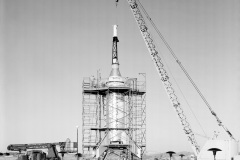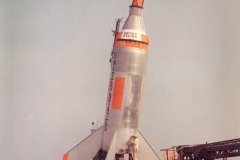The Mercury-Little-Joe 1 (LJ-1) mission was the first mission of the Mercury program to test the Mercury capsule’s rescue system.
On August 21, 1959, LJ-1 was prepared for takeoff from Wallops Flight Facility, Wallops Island, Virginia. 35 minutes before launch, the scheduled evacuation of the launch area took place and the batteries for the programmer and destruction systems in the Little Joe rocket were charged. Half an hour before the start, an explosive flash suddenly occurred. When the smoke cleared, it was clear that only the Mercury capsule containing the rescue rocket had been launched. And on a trajectory that resembled a break from the takeoff site. The Little Joe rocket remained intact on the launch platform.
The Mercury capsule reached a summit altitude of 640 meters. There was no separation of the rescue rocket from the capsule and the parachutes were not ejected, so that after 20 seconds the capsule crashed unbraked into the Atlantic Ocean about 800 meters away from the launch pad.
A faulty circuit of the batteries in the rescue rocket was identified as a source of error.
Mission data |
|
|---|---|
Mission |
Mercury-Little-Joe 1 (LJ-1) |
Rocket |
Little Joe |
Spacecraft |
Mercury Boilerplate |
Launch date |
August 21, 1959 |
Launch site |
Launch Area 1 (LA-1), Wallops Flight Facility, Virginia |
Mission duration |
20 sec |
Altitude |
0.640 km |
Distance |
0.8 km |
Velocity |
– |
Max G |
– |









